1998 CHEVROLET VENTURE warning
[x] Cancel search: warningPage 207 of 474
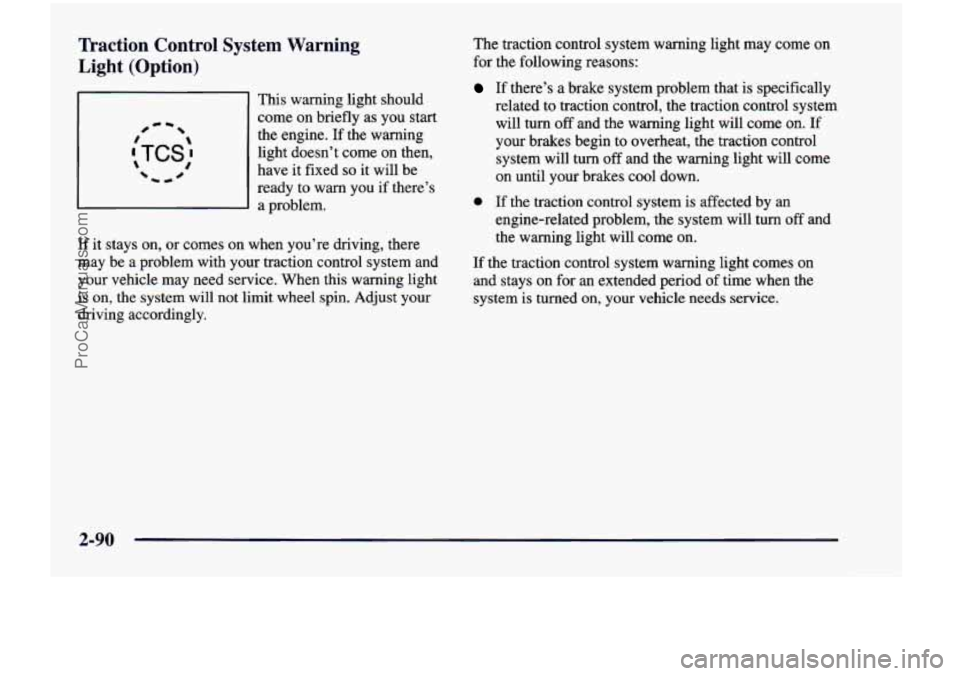
Traction Control System Warning
Light (Option)
This warning light should
come on briefly as you
start
the engine. If the warning
light doesn’t come on then,
have
it fixed so it will be
ready to warn you if there’s a problem.
If it stays on, or comes on when you’re driving, there
may be a problem with your traction control system and
your vehicle may need service. When this warning light
is on, the system will not limit wheel spin. Adjust your
driving accordingly. The
traction control system warning light may come on
for the following reasons:
If there’s a brake system problem that is specifically
related to traction control, the traction control system will turn
off and the warning light will come on. If
your brakes begin
to overheat, the traction control
system will
turn off and the warning light will come
on until your brakes cool down.
0 If the traction control system is affected by an
engine-related problem, the system will
turn off and
the warning light will come
on.
If the traction control system warning light comes on
and stays on for an extended period
of time when the
system
is turned on, your vehicle needs service.
2-90
ProCarManuals.com
Page 209 of 474
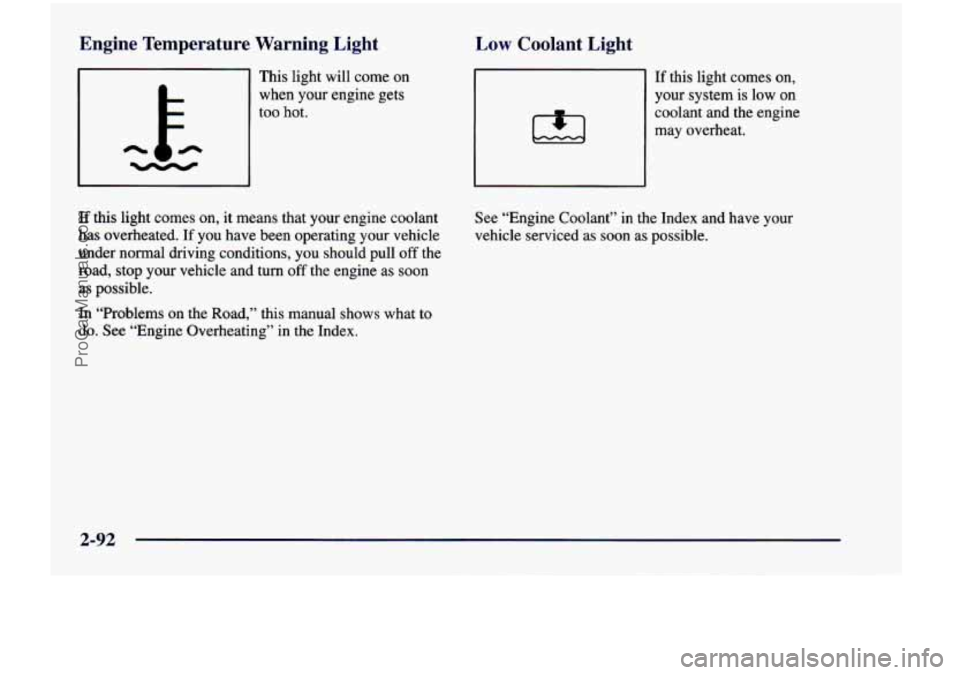
Engine Temperature Warning Light
This light will come on
when your engine gets
too hot.
Low Coolant Light
If this light comes on,
your system is low on
coolant and the engine
may overheat.
If this light comes on, it means that your engine coolant
has overheated. If you have been operating your vehicle
under normal driving conditions, you should pull
off the
road, stop your vehicle and turn off the engine as soon
as possible. See
“Engine Coolant” in the Index and have your
vehicle serviced as soon as possible.
In “Problems on the Road,” this manual shows what to
do. See “Engine Overheating” in the Index.
2-92
ProCarManuals.com
Page 212 of 474
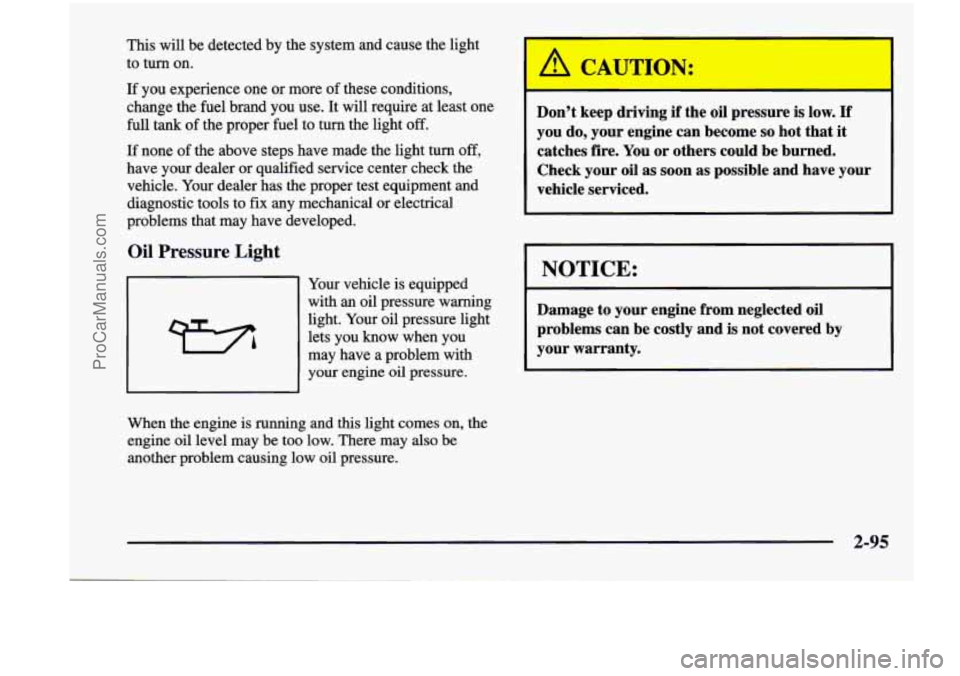
This will be detected by the system and cause the light
to turn on.
If you experience one or more of these conditions,
change the fuel brand you use. It
will require at least one
full tank of the proper fuel to turn the light off.
If none of the above steps have made the light turn off,
have your dealer or qualified service center check the
vehicle. Your dealer has the proper test equipment and
diagnostic tools to
fix any mechanical or electrical
problems that may have developed.
Oil Pressure Light
Your vehicle is equipped
with an oil pressure warning
light. Your oil pressure light
lets you know when you
may have a problem with
your engine
oil pressure.
When the engine is running and this light comes on, the
engine oil level may be too low. There may
also be
another problem causing low oil pressure. Don’t
keep driving if the
oil pressure is low. If
you do, your engine can become so hot that it
catches fire. You or others could be burned.
Check your
oil as soon as possible and have your
vehicle serviced.
NOTICE:
r
Damage to your engine from neglected oil
problems can be costly and
is not covered by
your warranty.
2-95
ProCarManuals.com
Page 213 of 474
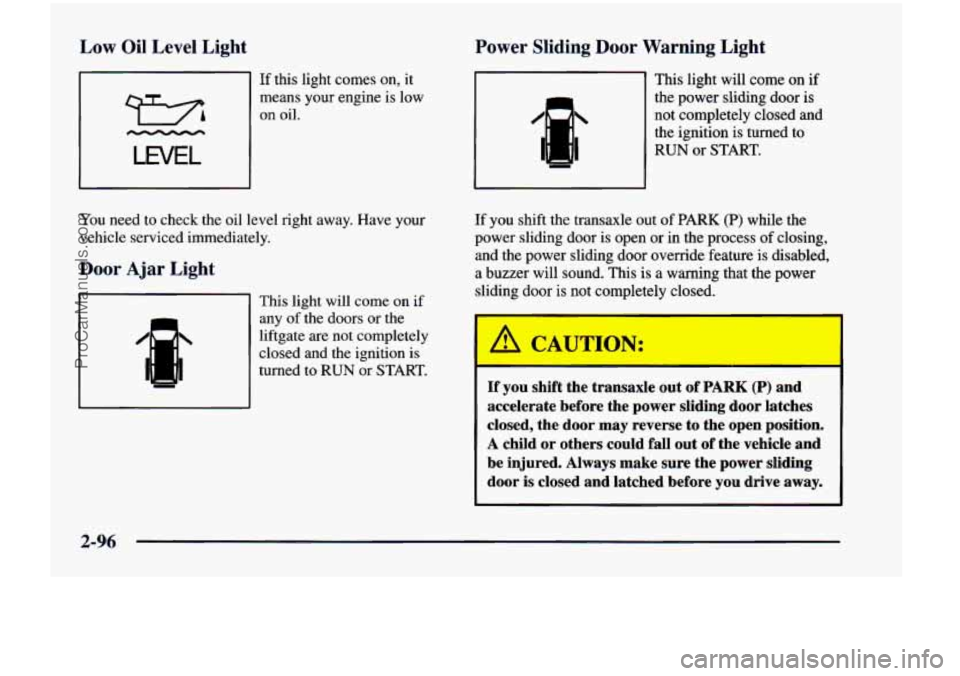
Low Oil Level Light
r I If this light comes on, it
means your engine is low
on oil.
LWEL
You need to check the oil level right away. Have your
vehicle serviced immediately.
Door Ajar Light
- This light will come on if
any of the doors or the
liftgate are not completely
closed and the ignition is
turned
to RUN or START.
Power Sliding Door Warning Light
1 ' This light will come on if
the power sliding door is
not completely closed and
the ignition is turned
to
RUN or START. i ill
If you shift the transaxle out of PARK (P) while the
power sliding door is open
or in the process of closing,
and the power sliding door override feature is disabled,
a buzzer will sound. This is a warning that the power
sliding door is not completely closed.
1 A C. U [ON:
If you shift the transaxle out of PARK (P) and
accelerate before the power sliding door latches
closed, the door may reverse to the open position.
A child or others could fall out of the vehicle and
be injured. Always make sure the power sliding door
is closed and latched before you drive away.
I
2-96
ProCarManuals.com
Page 214 of 474
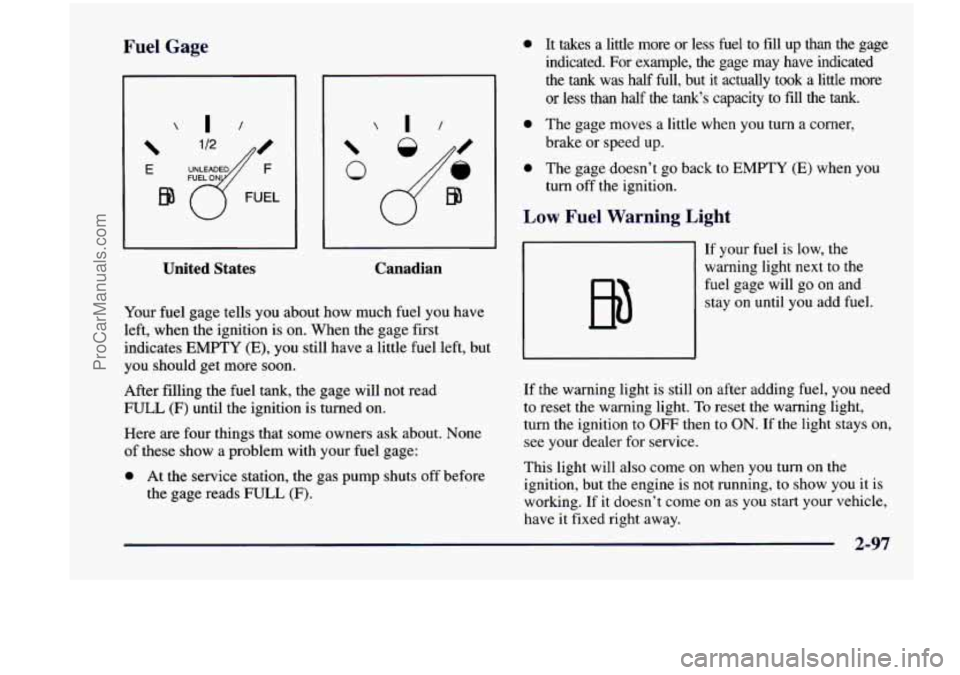
Fr. __ Gage
E
EQ
United States Canadian
Your fuel
gage tells you about how much fuel you have
left, when the ignition is on. When the gage first
indicates
EMPTY (E), you still have a little fuel left, but
you should get more soon.
After filling the fuel tank, the gage will not read
FULL
(F) until the ignition is turned on.
Here
are four things that some owners ask about. None
of these show a problem with your fuel gage:
0 At the service station, the gas pump shuts off before
the gage reads FULL
(F).
0 It takes a little more or less fuel to fill up than the gage
indicated.
For example, the gage may have indicated
the
tank was half Eull, but it actually took a little more
or less than half the tank‘s capacity to fill the tank.
0 The gage moves a little when you turn a corner,
brake or speed up.
0 The gage doesn’t go back to EMPTY (E) when you
turn off the ignition.
Low Fuel Warning Light
If your fuel is low, the
warning light next to the
fuel gage will go on and stay on until you add fuel.
If the warning light is still on after adding fuel, you need
to reset the warning light.
To reset the warning light,
turn the ignition to OFF then to
ON. If the light stays on,
see your dealer for service.
This light will also come on when you turn on the
ignition, but the engine is not running, to show you
it is
working. If it doesn’t come on as you start your vehicle,
have it fixed right away.
2-97
ProCarManuals.com
Page 260 of 474
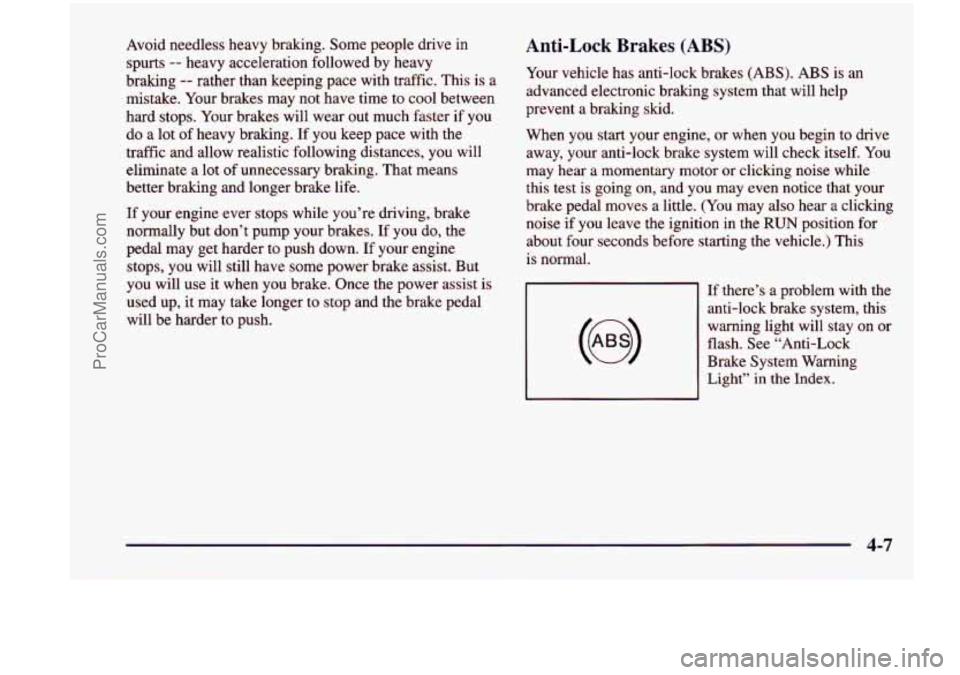
Avoid needless heavy braking. Some people drive in
spurts
-- heavy acceleration followed by heavy
braking
-- rather than keeping pace with traffic. This is a
mistake. Your brakes may not have time to cool between
hard stops. Your brakes
will wear out much faster if you
do a lot of heavy braking. If you keep pace with the
traffic and allow realistic following distances, you will
eliminate a lot
of unnecessary braking. That means
better braking and longer brake life.
If your engine ever stops while you’re driving, brake
normally but don’t pump your brakes. If you do, the
pedal may get harder to push down. If your engine
stops, you will still have some power brake assist. But
you will use it when you brake. Once the power assist is
used up, it may take longer to stop and the brake pedal
will be harder to push.
I - .Lock P
rour vehicle has anti-lock brakes (ABS). ABS is an
advanced electronic braking system that will help
prevent a braking skid.
When you start your engine, or when you begin
to drive
away, your anti-lock brake system will check itself. You
may hear a momentary motor or clicking noise while
this test is going on, and you may even notice that your
brake pedal moves a little. (You may
also hear a clicking
noise if you leave the ignition in the
RUN position for
about four seconds before starting the vehicle.) This
is normal.
‘;es (ABS)
If there’s a problem with the
anti-lock brake system, this
warning light will stay on or
flash. See “Anti-Lock
Brake System Warning
Light”
in the Index.
4-7
ProCarManuals.com
Page 263 of 474
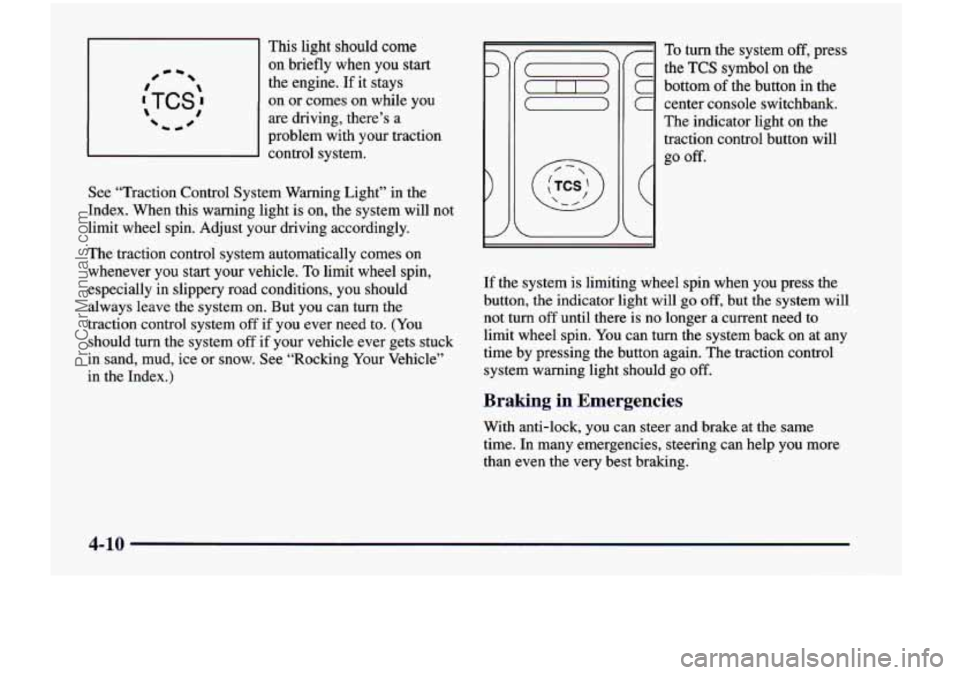
This light should come
on briefly when you start #- -
:TCS: 1 0
the engine. If it stays
on
or comes on while you
are driving, there’s a
problem with your traction
d control system.
See “Traction Control System Warning Light” in the
Index. When this warning light
is on, the system will not
limit wheel spin. Adjust your driving accordingly.
The traction control system automatically comes
on
whenever you start your vehicle. To limit wheel spin,
especially in slippery road conditions, you should
always leave the system on. But you can turn the
traction control system off if you ever need to. (You
should turn the system off if your vehicle ever gets stuck
in sand, mud, ice or snow. See “Rocking Your Vehicle”
in the Index.)
7
C
C
C
(
L
To turn the system off, press
the
TCS symbol on the
bottom
of the button in the
center console switchbank.
The indicator light on the
traction control button will
go
off.
If the system is limiting wheel spin when you press the
button,
the indicator light will go off, but the system will
not turn
off until there is no longer a current need to
limit wheel spin. You can turn the system back
on at any
time by pressing the button again. The traction control
system warning light should go
off.
Braking in Emergencies
With anti-lock, you can steer and brake at the same
time. In many emergencies, steering can help you more
than even the very best braking.
4-10
ProCarManuals.com
Page 268 of 474
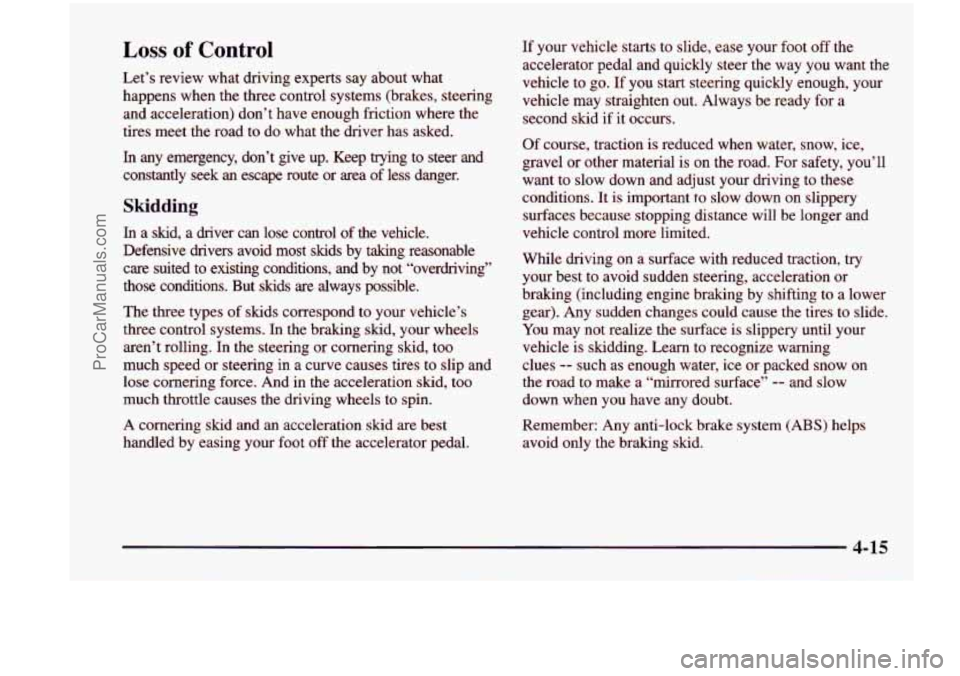
Loss of Control
Let’s review what driving experts say about what
happens when the three control systems (brakes, steering
and acceleration) don’t have enough friction where the
tires meet the road to do what the driver has asked.
In any emergency, don’t give up. Keep trying to steer and
constantly seek
an escape route or area of less danger.
Skidding
In a skid, a driver can lose control of the vehicle.
Defensive drivers avoid most skids by taking reasonable
care suited to existing conditions, and by not “overdriving”\
those conditions. But skids are always possible.
The three types of skids correspond to your vehicle’s
three control systems. In the braking skid, your wheels
aren’t rolling. In the steering
or cornering skid, too
much speed or steering in a curve causes tires to slip and
lose cornering force. And in the acceleration skid, too
much throttle causes the driving wheels
to spin.
A cornering
skid and an acceleration skid are best
handled by easing your foot
off the accelerator pedal. If
your vehicle starts to slide, ease your foot off the
accelerator pedal and quickly steer the way you want the
vehicle to go.
If you start steering quickly enough, your
vehicle may straighten out. Always be ready for a
second skid if it occurs.
Of course, traction is reduced when water, snow, ice,
gravel or other material is on the road. For safety, you’ll\
want to slow down and adjust your driving to these
conditions. It is important
to slow down on slippery
surfaces because stopping distance will be longer and
vehicle control more limited.
While driving on a surface with reduced traction,
try
your best to avoid sudden steering, acceleration or
braking (including engine braking by shifting to a lower
gear). Any sudden changes could cause the tires to slide.
You may not realize the surface is slippery until your
vehicle is skidding. Learn to recognize warning
clues
-- such as enough water, ice or packed snow on
the road to make a “mirrored surface” -- and slow
down when you have any doubt.
Remember: Any anti-lock brake system
(ABS) helps
avoid only the braking skid.
ProCarManuals.com